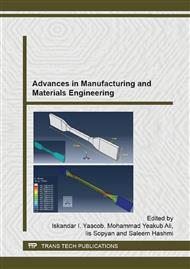p.390
p.394
p.398
p.402
p.406
p.410
p.414
p.418
p.422
The Effects of Coupling Agent on the Flame Retardant Properties of PP/ATH Nanocomposites
Abstract:
It is known that polymeric materials are easily to get on fire due to their chemical structures. Thus the flame retardant material such as aluminium hydroxide (ATH) is used to improve the flame retardancy property of polymers. Polypropylene (PP) with various amount of nanosized ATH particles of (5, 10, 20, 30, 40 wt%) were compounded with an extruder machine. The effects of two different type of coupling agent (3-Aminopropyltriethoxysilane (APS) and Maleic anhydride grafted polypropylene (MAPP)) on the flame retardant properties were compared. All samples were characterized with two flame tests; the limiting oxygen index (LOI) and UL94 horizontal burning test (UL94 HB). It is found that both tests showed improvement on the flame resistance properties of the nanocomposites, mainly at high ATH loadings. Type of coupling agents affects the flame retardancy properties of PP/ATH nanocomposites.
Info:
Periodical:
Pages:
406-409
Citation:
Online since:
July 2015
Price:
Сopyright:
© 2015 Trans Tech Publications Ltd. All Rights Reserved
Share:
Citation:


